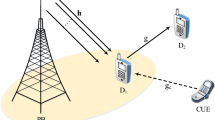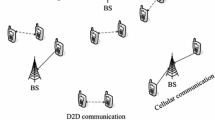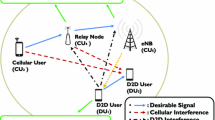Abstract
In this paper, device to device (D2D) network is studied to support transmission in close distance among group of two users. Such two users benefit from new technique of multiple access, namely non-orthogonal multiple access. Two modes of D2D are considered, such as direct and relay links. Energy harvesting and design of multiple antennas have main impacts on system performance. We derive the closed-form expressions of outage probability for two devices in many scenarios. The Decode and Forward relaying scheme is adopted in this study. To ensure the quality of service (QoS) for the devices, suitable mode can be decided based on specific demand. We compare system performance by varying main parameters such as power allocation factors or transmit signal to noise ratio. Numerical results are performed to verify the effectiveness of the proposed D2D transmission strategies.








Similar content being viewed by others
References
Zhang, Z., Long, K., Vasilakos, A. V., & Hanzo, L. (2016). Full-duplex wireless communications: Challenges, solutions, and future research directions. Proceedings of the IEEE, 104(7), 1369–1409.
Bariah, L., Muhaidat, S., & Al-Dweik, A. (2020). Error performance of NOMA-based cognitive radio networks with partial relay selection and interference power constraints. IEEE Transactions on Communications, 68(2), 765–777.
Song, Y., Yang, W., Xiang, Z., Sha, N., Wang, H., & Yang, Y. (2020). An analysis on secure millimeter wave NOMA communications in cognitive radio networks. IEEE Access, 8, 78965–78978.
Ku, M.-L., Li, W., Chen, Y., & Liu, K. J. R. (2016). Advances in energy harvesting communications: Past, present, and future challenges. IEEE Communications Surveys and Tutorials, 18(2), 1384–1412. 2nd Quart.
Mosavat-Jahromi, H., Maham, B., & Tsiftsis, T. A. (2017). Maximizing spectral efficiency for energy harvesting-aware WBAN. IEEE Journal of Biomedical and Health Informatics, 21(3), 732–742.
Nguyen, H.-S., Do, D.-T., Nguyen, T.-S., & Voznak, M. (2017). Exploiting hybrid time switching-based and power splitting-based relaying protocol in wireless powered communication networks with outdated channel state information. Automatika—Journal for Control, Measurement, Electronics, Computing and Communications, 58(1), 111–118.
Do, D.-T. (2015). Power switching protocol for two-way relaying network under hardware impairments. Radioengineering, 24(3), 765–771.
Yang, G., Ho, C. K., Zhang, R., & Guan, Y. L. (2015). Throughput optimization for massive MIMO systems powered by wireless energy transfer. IEEE Journal on Selected Areas in Communications, 33(8), 1640–1650.
Nguyen, H.-S., Bui, A.-H., Do, D.-T., & Voznak, M. (2016). Imperfect channel state information of AF and DF energy harvesting cooperative networks. China Communications, 13(10), 11–19.
Do, D.-T. (2016). Optimal throughput under time power switching based relaying protocol in energy harvesting cooperative network. Wireless Personal Communications, 87(2), 551–564.
Tutuncuoglu, K., Varan, B., & Yener, A. (2015). Throughput maximization for two-way relay channels with energy harvesting nodes: The impact of relaying strategies. IEEE Transactions on Communications, 63(6), 2081–2093.
Wang, X., Liu, J., & Zhai, C. (2017). Wireless power transfer-based multi-pair two-way relaying with massive antennas. IEEE Transactions on Wireless Communications, 16(11), 7672–7684.
Ma, Y., Chen, H., Lin, Z., Li, Y., & Vucetic, B. (2015). Distributed and optimal resource allocation for power beacon-assisted wireless-powered communications. IEEE Transactions on Communications, 63(10), 3569–3583.
Al-Imari, M., Xiao, P., & Imran, M. A. (August, 2015). Receiver and resource allocation optimization for uplink NOMA in 5G wireless networks. In Proceedings of the International Symposium on Wireless Communication Systems (ISWCS) (pp. 151–155). https://doi.org/10.1109/ISWCS.2015.7454317.
Saito, Y., Benjebbour, A., Kishiyama, Y., & Nakamura, T. (September, 2013). Systemlevel performance evaluation of downlink non-orthogonal multiple access (NOMA). In Proceedings of the IEEE 24th annual international symposium personal, indoor, mobile radio communications (PIMRC) (pp. 611–615).
Zuo, H., & Tao, X. (October, 2017). Power allocation optimization for uplink nonorthogonal multiple access systems. In Proceedings of the 9th International Conference on Wireless Communications Signal Processing (WCSP) (pp. 1–5).
Na, Z., Lv, J., Jiang, F., Xiong, M., & Zhao, N. (2019). Joint subcarrier and subsymbol allocation-based simultaneous wireless information and power transfer for multiuser GFDM in IoT. IEEE Internet of Things Journal, 6(4), 5999–6006.
Do, D.-T., Le, A.-T., & Lee, B.-M. (2019). On performance analysis of underlay cognitive radio-aware hybrid OMA/NOMA networks with imperfect CSI. Electronics, 8(7), 819.
Li, X., Wang, Q., Peng, H., Zhang, H., Do, D.-T., Rabie, K. M., et al. (2020). A unified framework for HS-UAV NOMA networks: Performance analysis and location optimization. IEEE Access, 8, 13329–13340.
Do, Dinh-Thuan, Le, A., & Lee, B. M. (2020). NOMA in cooperative underlay cognitive radio networks under imperfect SIC. IEEE Access, 8, 86180–86195.
Do, D.-T., & Le, A.-T. (2019). NOMA based cognitive relaying: Transceiver hardware impairments, relay selection policies and outage performance comparison. Computer Communications, 146, 144–154.
Nguyen, T.-L., & Do, D.-T. (2018). Power allocation schemes for wireless powered NOMA systems with imperfect CSI: System model and performance analysis. International Journal of Communication Systems, 31(15), e3789.
Dang, H., Van Nguyen, M., Do, D., Pham, H., Selim, B., & Kaddoum, G. (2020). Joint relay selection, full-duplex and device-to-device transmission in wireless powered NOMA networks. IEEE Access, 8, 82442–82460.
Lv, L., Ding, Z., Ni, Q., & Chen, J. (2018). Secure MISO-NOMA transmission with artificial noise. IEEE Transactions on Vehicular Technology, 67(7), 6700–6705.
Zhu, J., Zou, Y., Wang, G., Yao, Y.-D., & Karagiannidis, G. K. (2016). On secrecy performance of antenna-selection-aided MIMO systems against eavesdropping. IEEE Transactions on Vehicular Technology, 65(1), 214–225.
Le, C.-B., & Do, D.-T. (2019). Joint evaluation of imperfect SIC and fixed power allocation scheme for wireless powered D2D-NOMA networks with multiple antennas at base station. Wireless Networks, 25(8), 5069–5081.
Gradshteyn, I. S., & Ryzhik, I. M. (2007). Table of integrals, series and products (7th ed.). New York: Academic Press.
Author information
Authors and Affiliations
Corresponding author
Additional information
Publisher's Note
Springer Nature remains neutral with regard to jurisdictional claims in published maps and institutional affiliations.
Appendix
Appendix
Proof of Proposition 2
Based on (26), the outage probability of \(U_3\) can be expressed as
Furthermore, \({{\varTheta _1}}\) can be calculated as
Next, \({{\varTheta _2}}\) is computed by
Based on (32), let \(\sigma = \max \left( {\frac{{{\mu _2}}}{{\beta \left( {{\delta _3} - {\mu _2}{\delta _4}} \right) }},\frac{{{\mu _2}}}{{{\delta _4}\beta }}} \right) \), \({{\varTheta _2}}\) can be calculated as
Plugging above values of (31) and (33) into (30) we obtain final formula.
This is end of proof. \(\square \)
Proof of Proposition 3
The outage probability for \(U_2\) can therefore be obtained as
With \({\delta _3} > {\mu _1}{\delta _4}\), it can be given that
By using the \( \int _0^\infty {{e^{\left( { - \frac{\beta }{{4x}} - \gamma x} \right) }}dx = \sqrt{\frac{\beta }{\gamma }} {\mathrm{K}_1}\left( {\sqrt{\beta \gamma } } \right) } \) [27].
Similarly, it can be obtained the closed-form of \(U_3\) such as
It completes Proposition 3. \(\square \)
Rights and permissions
About this article
Cite this article
Do, DT., Van Nguyen, MS. New Look on Device to Device NOMA Systems: with and Without Wireless Power Transfer Modes. Wireless Pers Commun 116, 2485–2500 (2021). https://doi.org/10.1007/s11277-020-07806-0
Published:
Issue Date:
DOI: https://doi.org/10.1007/s11277-020-07806-0




